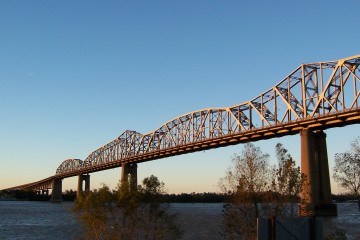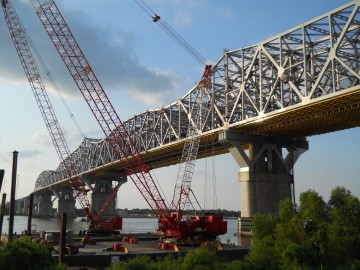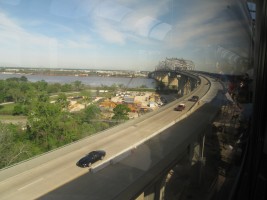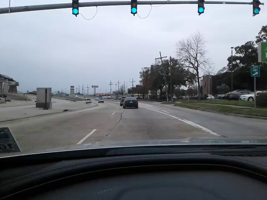The Huey P. Long Bridge
The Huey P. Long Bridge is a cantilevered steel through truss bridge that opened in 1935. It was built to carry two tracks of the Southern Pacific Railroad over the Mississippi River at mile 106.1 with two narrow lanes of traffic for US Highway 90 on either side of the tracks. The widest clean span is 790 feet long and sits 135 feet above the water. There are three navigation channels below the bridge, the widest being 750 feet. The distinctive rail structure is 22,996 feet long and extends as a rail viaduct well into the city. The highway structure was 8,076 feet long with extremely steep grades on both sides. The deck was a precarious 36 feet wide but, because of the railroad component, was unusually flat for a bridge of this height.
The foundation of the bridge is also unique. The land in and around New Orleans was formed by silt deposited by the Mississippi River. The clay topsoil (locally called "gumbo" and notorious for its role in the Hurricane Katrina levee failures) is compressible and unsuitable for foundation loads. Bedrock is around 1,000 feet below the surface, making it too deep for normal bridge foundation construction. So, the main piers are seated on a layer of fine sand 160 to 170 feet below Mean Gulf Level and rely on their massive weight and girth to hold them in place.
The bridge dates from an era when the construction of large works presented significant engineering challenges and the needs of rail and auto travel were more matched than they are today. Large bridges mixing rail tracks and highways were common, as typified by the 1909 MacArthur Bridge and 1910 McKinley Bridge in St. Louis, and the 1916 Harahan Bridge in Memphis. A similarly massive 1940 bridge in Baton Rouge, LA, also named the Huey P. Long Bridge was patterned after the New Orleans bridge and was pretty much the last of its kind. Most of these hybrid bridges have been converted either to entirely rail or entirely auto use and new large bridges are always devoted exclusively to meeting increasing vehicular traffic demands. Current rail demands are well met by existing bridges that are a testament to the care and craftsmanship of our forefathers.
The history of the Huey P. Long bridge is almost as complex as the bridge structure itself. As early as 1892 the Southern Pacific Railway proposed a high level bridge, but a depression that year prevented further work on a project that would have been an overwhelming challenge for the engineers of the time due to soil conditions and extremely high clearances needed to clear river navigation. With the development of the Public Belt Railroad System, interest in a river rail crossing grew and lead to passage of a constitutional amendment in 1916 granting the city exclusive power to build and operate a crossing. Three general ideas emerged from the planning process: a low-level drawbridge, a tunnel and a high-level bridge. The tunnel idea died first because it would have provided limited capacity and the War Department (after years of wrangling) ultimately rejected the idea of a drawbridge as inappropriate for such a significant concentration of vital infrastructure.
Design work began in earnest in 1925 and some pilings were actually driven that year to prevent expiration of congressional authority and provide further information for the design. As the magnitude of the project became apparent and projected costs ballooned, financing difficulties compounded by the Great Depressions delayed the project. Finally, on November 5, 1932, the bonds of the Public Belt Railroad Commission were guaranteed by a complex agreement between the Southern Pacific Railroad, the City of New Orleans and the State of Louisiana. Main construction contracts were signed on December 30, 1932 and work formally started the following day. Construction of the bridge proceeded smoothly over a three-year period with only minor interruptions due to high water and a one-month strike in September of 1933. The Huey P. Long bridge was formally dedicated at noon on December 16, 1935 and was named after an extremely popular and notorious governor and senator who had been assassinated in the state capital on September 8, 1935, just three months before the bridge opened.
A four-phase project was begun in April 2006 to enhance the bridge by widening the terrifyingly substandard highway component with three 11-foot lanes on each side, 8-foot outside shoulders and 2-foot inside shoulders. This required widening the piers to support the extra load, while leaving the center railroad component largely unchanged. The ribbon cutting for the renovated bridge was held on June 16, 2013. While the new bridge is important to the area and should be much safer for drivers, it certainly loses much of the nostalgic grit that has made the Huey P. Long bridge such a noble representative of its time.
(Parts of this essay were used to revise the Huey P. Long bridge entry on Wikipedia.org)



